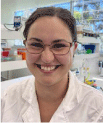ASM summer student research awards: 2024
Priscilla Johanesen AA
This year, the society was thrilled to once again have so much interest from students in the ASM Summer Research Awards. Established as a national program in 2018, these awards offer students a unique opportunity to immerse themselves in the world of microbiology research, providing hands-on learning and invaluable skill development in a dynamic research environment. This year the society awarded ten ASM Summer Student Research Awards across Australia. The successful awardees for this year were: Tiana Davey, Phillip McFadden, Aasha McMurray-Jones, Tristan Mendoza and Jacob Smith from Queensland; Clarice Harker from South Australia; Alexandra Gruber and Gypsy Mallam from Tasmania; and Justin Castlehow and Liza Mantjani from Western Australia. Congratulations to all 2024 Summer Student Research Awardees – we wish you well on your research journey and all the best for the future.
Queensland
Molecular diagnostics development for rapid human fungal infection detection and identification
Tiana R. DaveyA,B, Derek S. SarovichA,B and Erin P. PriceA,B
ACentre for Bioinnovation, University of the Sunshine Coast, Sippy Downs, Qld, Australia
BSunshine Coast Health Institute, Birtinya, Qld, Australia
Abstract. Invasive fungal disease (IFD) has gained recognition in recent years across the globe, as its prevalence and propensity for causing disease comes to light. These fungal pathogens predominantly affect immunocompromised patients and are associated with high morbidity and mortality. Diagnosis and treatment of IFD is plagued by long turnaround times, insensitive diagnostic tests and limited antifungal drugs; this limited arsenal grows smaller as antifungal resistance rates rise. This delay often leads to empirical, non-targeted treatment, further promoting antimicrobial resistance and contributing to suboptimal patient outcomes. The need for rapid, accurate diagnostic tests for common IFD-causing fungi is evident. To meet this urgent need, we developed and validated 10 novel quantitative real-time polymerase chain reaction (qPCR) assays targeting 10 prevalent fungal pathogens affecting humans: Aspergillus flavus, Aspergillus fumigatus, Section Fumigati, Section Flavi, Nakaseomyces glabratus, Pichia kudriavzevii, Candida albicans, Candida dubliniensis, Candida parapsilosis and Candida tropicalis. All 10 qPCR assays demonstrate excellent specificity towards the chosen targets and good detection sensitivity and quantitation capacity. To enable high-throughput screening of fungal cultures, these assays have been validated in duplex format, allowing for two assay targets to be simultaneously tested in a singular tube.
Characterisation of the expression of the non-typeable Haemophilus influenzae Hia protein
Phillip McFadden, Ashley Fraser and Jon M. Atack
Institute for Glycomics, Griffith University, Gold Coast, Qld, Australia
Abstract. Non-typeable Haemophilus influenzae (NTHi) is a bacterial pathogen that is a significant cause of illness and mortality among young children and adults globally. The rates of NTHi invasive disease have been steadily rising since the introduction of the Haemophilus influenzae type b (Hib) vaccine in 1993. NTHi exhibits extreme genetic and phenotypic diversity between strains and as a result there is currently no vaccine available. Haemophilus influenzae adhesin (Hia) is an autotransporter protein found in ~25% of NTHi strains and is a key adhesin of NTHi. The expression of the Hia protein is phase-variable, changes in length of a poly-T tract in the hia promoter lead to high or low expression. We hypothesise that the varying lengths of the poly-T tract alters local DNA structure leading to differences in the binding efficiency of RNA polymerase to the hia promoter. We investigated this hypothesis using E. coli RNA polymerase, which is commercially available, in order to study how RNA polymerase binds to the hia promoter containing different poly-T tract lengths using gel-shift assays. Our study demonstrated that the NTHi promoter (the hia promoter) is able to be recognised and expressed in E. coli by the use of a simple β-galactosidase::hia promoter fusion placed in single copy in E. coli, validating the use of commercially available E. coli RNA polymerase in future gel-shift assays.
Plate sweeps for hospital surveillance of bacteria in a new Intensive Care Unit
Aasha McMurray-Jones and Leah Roberts
Queensland University of Technology, Brisbane, Qld, Australia
Abstract. Hospital-acquired infections (HAI) pose a significant threat to patient health outcomes in Australia, and the increasing prevalence of antimicrobial resistance (AMR) intensifies these risks. As such, there is a critical need for adequate bacterial surveillance techniques to become standard practice in healthcare settings. Next Generation Whole Genome Sequencing (NG WGS) offers greater microbial typing resolution than traditional diagnostics but is not used routinely in surveillance of the hospital environment. Metagenomics, which has been proven to be useful in environmental surveillance during outbreak investigations, has not yet become established due to the high associated costs. Environmental plate sweeps, which constitute an enriched proportion of the hospital microbiome, offer a practical solution for establishing reliable hospital surveillance. Our study monitored a newly opened intensive care unit (ICU) in Toowoomba over a 3-month period, sampling before and after patient and staff introduction. We aimed to establish a routine surveillance method for bacterial pathogens incorporating plate sweep techniques and NG WGS. Our results demonstrated rapid colonisation of pathogenic bacteria in the ICU environment after staff and patient introduction, many carrying multiple AMR and virulence genes. This emphasises the importance of implementing advanced surveillance techniques to proactively manage HAI risks and inform infection control processes.
Decoding bacterial epigenetic regulation of Neisseria gonorrhoeae
Tristan Mendoza, Alice Ascari, Luke Blakeway and Kate Seib
Institute for Glycomics, Griffith University, Gold Coast, Qld, Australia
Abstract. Neisseria gonorrhoeae is a Gram-negative bacterial pathogen that causes the sexually transmitted infection gonorrhoea. Rapid evolution and antibiotic resistance have led to N. gonorrhoeae having 82.4 million new infections per annum. The World Health Organization classed it as a High Priority bacterium for the research and development of new antibiotics. One of the mechanisms for rapid evolution is phase variation of their mod DNA methyltransferases, which regulate the global DNA methylation pattern of the genome. N. gonorrhoeae expresses modA13, modA12, modB1 and modB2. Each allele contains a tandem repeat region. Phase variation regulates their expression by randomly inserting repeats into the repeat tracts, which can change whether a premature stop codon is read and therefore, changing the expression of the mod gene. This study focused on characterising the mod alleles in two clinical isolates, N. gonorrhoeae 1291 and N. gonorrhoeae 88G285 by the mod allele they have and whether it is ON or OFF. This was achieved by analysing a panel of N. gonorrhoeae clinical isolates through bioinformatics, PCR of the repeat tracts in their mod genes and fragment length analysis to determine the exact length and population percentage of each repeat length.
Investigating the adhesion of Pseudomonas aeruginosa laboratory and clinical endocarditis strains to extracellular matrix components
Jacob M Smith, Sarah Hickson and Timothy J. Wells
Frazer Institute, The University of Queensland, Brisbane, Qld, Australia
Abstract. Pseudomonas aeruginosa is an important nosocomial bacterial pathogen responsible for various acute and chronic infections. In rare cases, it can colonise heart valves to cause infective endocarditis (IE); however, mechanisms of adhesion and colonisation remain unclear. For other IE pathogens such as Staphylococcus aureus, adhesion to specific matrix components is critical in the establishment of infection. Here, we aimed to assess the adhesion of clinical P. aeruginosa isolated from patients with endocarditis to collagen I and collagen IV, which are abundant in extracellular matrices, and investigate if clinical isolates promote collagen adhesion in comparison with well-established laboratory strains. Five of the six endocarditis strains exhibited adhesion to collagen coated plates, however the adhesion was not specific with the isolates binding equally well to the BSA coated control. Thus, no evidence was found of specific adhesion to these collagen proteins. Future studies will expand the ECM molecules investigated, as well as look at total ECM binding assays to better understand the adhesion targets of P. aeruginosa in the endocardium.
South Australia
Bacteriophage therapy: utilising bacterial viruses, to target antibiotic resistant Stenotrophomonas maltophilia infections
Clarice HarkerA, Sarah GilesA, Bhavya PapudeshiA, Michael RoachB, Morgyn WarnerC and Robert EdwardsA
ACollege of Science and Engineering, Flinders University, SA, Australia
BFaculty of Health and Medical Science, University of Adelaide, SA, Australia
CInfectious Diseases Unit, Queen Elizabeth Hospital, SA, Australia
Abstract. Phage therapy (PT) presents a promising avenue for addressing the morbidity and mortality caused by multidrug-resistant (MDR) organisms, notably Stenotrophomonas maltophilia – an opportunistic pathogen prevalent in South Australian respiratory clinics, particularly affecting individuals with cystic fibrosis (CF). Recognising the critical need for effective treatment, Australia’s first Stenophage bank has been established, housing 10 distinct lytic Caudovirales phages. Long-read sequencing has confirmed their suitability for therapeutic use, revealing an absence of genes associated with lysogeny, toxins, virulence or antibiotic resistance. These phages demonstrate a broad host range, effectively targeting 27 out of 30 clinical S. maltophilia strains, with only 3 strains proving resistant. Further investigation is warranted for phages ASP, Veg and APy, for potential utilisation in phage combination therapy to provide a rapid, effective treatment option against prevalent S. maltophilia isolates. This study presents the preliminary characterisation of this phage bank, including their host range and genomic suitability screening, laying the groundwork for future advancements in characterising and exploring their therapeutic potential. Through analysis of phage and host genomes, we sought to enhance the understanding and therapeutic potential of our phage combinations, ultimately aiming to alleviate the economic and healthcare burdens associated with S. maltophilia infections.
Tasmania
Activity of ST-2023 against nontypeable Haemophilus influenzae biofilms
Alexandra GruberA, Prajna Paramita TaslimA, Robyn MarshA,B, Stephen TristramA and Brianna AttoA
AUniversity of Tasmania, School of Health Sciences, Launceston, Tas., Australia
BChild and Maternal Health Division, Menzies School of Health Research, Charles Darwin University, Darwin, NT, Australia
Abstract. Non-typeable Haemophilus influenzae (NTHi) is a leading cause of middle ear infections in children and exacerbations of chronic obstructive pulmonary disease in adults. Despite antibiotic treatment, infections caused by NTHi are frequently persistent and recurring, and often lead to long-term health complications. The chronicity of NTHi infections is linked to the formation of biofilms, which are largely impervious to immune and antibiotic clearance. Thus, new therapies that target these biofilms is key to reducing the high disease burden associated with NTHi infection. One such approach is the use of bacterially derived antibacterial peptides (bacteriocins), such as ST-2023, which directly inhibit the growth of NTHi. This study aimed to determine if ST-2023 could both prevent biofilm formation or disrupt already-established biofilms of NTHi isolates from different anatomical sites using a crystal violet assay. Our data suggest that ST-2023 is a potentially potent inhibitor, and disruptor of NTHi biofilm, however; further work is warranted to elucidate the exact mechanism of action and therapeutic utility.
Evaluation of the performance of MinION to examine microbial communities in a food matrix
Gypsy Mallam, Laura Rood, Jay Kocharunchitt and Elerin Toomik
Tasmanian Institute of Agriculture, University of Tasmania, Hobart, Tas., Australia.
Abstract. MinION is a portable nanopore sequencer capable of sequencing whole 16S rRNA genes, the gold standard for identification of bacterial species. This study evaluated whether the number of reads generated by MinION is proportional to the 16S rRNA copy number as well as assessing MinION’s performance at detecting low abundances of bacterial isolates in broth and a food matrix. Various mock communities, made up of Bacillus cereus, Listeria innocua, Staphylococcus aureus and Xanthomonas campestris, were sequenced for their 16S rRNA gene using MinION Mk1C. The results were reproducible between replicates, although Xanthomonas was incorrectly identified as Pseudomonas across all samples, and MinION has the ability to detect isolates at low abundances in broth and meat rinsate. The number of reads, however, were only proportional for the isolate with the highest copy number, and abundance levels were not completely accurate for the isolates with low concentration. This level of accuracy shows that MinION is able to detect multiple organisms in food production and storage and thereby could be used to study the microbial ecology of foods or as part of a monitoring program to ensure the microbiological safety of foods.
Western Australia
Flow cytometry reveals trends of higher B-cell counts from FLOQ® swab than Dent-o-care™ interdental brush
Justin CastlehowA,B, Christian TjiamA,B and Lea-Ann KirkhamA,B
AWesfarmers Centre of Vaccines and Infectious Diseases, Telethon Kids Institute, Perth, WA, Australia
BCentre for Child Health Research, University of Western Australia, Perth, WA, Australia
Abstract. As respiratory infection vaccinations shift from a systemic to mucosal approach, a revised specimens collection method is required to accurately represent the mucosal immune response. A review of the literature demonstrated a lack of research comparing different methods for counting cells of the mucosal immune system. To address this, two sampling techniques were compared for their effectiveness of sampling mucosal immune cells using flow cytometry at the Telethon Kids Institute under the supervision of Assoc. Prof. Lea-Ann Kirkham and Dr Christian Tjiam to compare the number of immune cells eluted from either Copan FLOQ® swabs or Dent-o-care™ interdental brushes. Five healthy participants volunteered for nasopharyngeal swabbing on the left nostril and an interdental brush for mid-nasal collection up the right nostril. A Wilcoxon paired signed-rank test showed insignificant P-values for all samples. Although the interdental brush collected a higher median of CD45⁺ cells, there was a trend in which the FLOQ swab had eluted higher B-cell counts across all subsets compared to the interdental brushes, especially class switched memory B-cells. This indicates that further research with a larger cohort may produce statistically significant results for FLOQ B-cell collection and is a better representative for the mucosal response to vaccination.
Determining the effect of secondary metabolites from pathogenic fungi on cell viability, growth and phagocytosis
Liza MantjaniA, Yit-Heng ChooiA and Luke GarrattB
ASchool of Molecular Sciences, University of Western Australia, WA, Australia
BWal-Yan Respiratory Research Centre, Telethon Kids Institute, University of Western Australia, WA, Australia
Abstract. Pathogenic fungi employ a range of virulence factors to establish and maintain infection. One mechanism is bioactive molecules termed secondary metabolites. This project aimed to describe the activity of metabolites from a range of fungal pathogens including Scedosporium aurantiacum, a pathogen of concern for people living with cystic fibrosis. To understand the function of these compounds, cell viability and proliferation assays were performed. In addition, a fungal-specific THP-1 phagocytosis assay was established using FITC-labelled conidia and anti-FITC counterstaining to distinguish internalised and external-bound conidia. This phagocytosis assay was used to determine any effect of compounds on immune cell clearance capacity. Six of the compounds tested caused reduced cell viability or inhibited proliferation. A portion of the compounds tested caused reduced internalisation events of THP-1 cells, suggesting they would interfere with clearance of conidia. The same was performed for neutrophils, however phagocytosis rates were lower and was less able to distinguish the effect of compounds. This project provides a foundation for additional research into the bioactivity of secondary metabolites from pathogenic fungi. This newly established phagocytosis assay can be applied to other pathogens to further understand their mechanisms of virulence and contribute to novel treatments and diagnostic tests.













